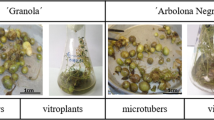Abstract
The virulence of 174 isolates ofRhizoctonia solani AG-3 was evaluated on potato stems in a greenhouse test. Isolates obtained from lesions on stolons, sclerotia on tubers, and hymenia on aerial stems were the most virulent, those from below ground stem lesions were intermediate, and single basidiospore isolates were the least virulent. TheRhizoctonia disease syndrome was evaluated in three areas: on irrigated sand at Becker, Minnesota, on nonirrigated heavy loam soil at Grand Forks, North Dakota, and on peat soil, Anoka, Minnesota. The disease was most severe on irrigated sand, intermediate on heavy loam, and the least disease occurred on peat soil. An inoculation method using corn kernels infested with a virulent isolate ofRhizoctonia solani was effective in causing disease. Seed tubers with up to 15 percent of their surface area covered with sclerotia did not cause significant disease. In these tests, sclerotia on tubers caused more disease than soil borne inoculum.
Compendio
En una prueba de invernadero se evaluó la virulencia de 174 aislamientos deRhizoctonia solani AG-3 sobre tallos de papa. Los aislamientos obtenidos de lesiones en los estolones, esclerocios sobre los tubérculos, e himenios sobre tallos aéreos fueron los más virulentes, aquellos procedentes de lesiones de tallos bajo tierra fueron intermedios y los aislamientos de una basidiospora los menos virulentos. El síndrome de la Rhizoctoniasis fue evaluado en tres zonas: en suelo arenoso bajo riego, en Becker, Minnesota, en suelo altamente margoso, en Grand Forks, North Dakota y en suelo turboso, en Anoka, Minnesota. La enfermedad fue más severa en el suelo arenoso bajo riego, intermedia en suelo altamente margoso y menos severa en el suelo turboso. Un método de inoculación, utilizando granos de maíz infestados con un aislamiento virulente deRhizoctonia solani, fue efectivo para reproducir la enfermedad. Tubérculos-semillas hasta con 15 % de su superficie cubierta con esclerocios, no reprodujeron la enfermedad de manera significativa.
En estas pruebas, los esclerocios sobre los tubérculos fueron más virulentos que el inóculo presente en el suelo.
Similar content being viewed by others
Literature Cited
Allington, W.B. 1936. Sclerotial formation ofRhizoctonia solani as affected by nutritional and other factors. Phytopathology 26:831–844.
Anderson, N.A., H.M. Stretton, J.V. Groth, and N.T. Flentje. 1972. Genetics of heterokaryosis inThanatephorus cucumeris. Phytopathology 62:1057–1065.
Bandy, B.P., D.H. Zanzinger, and S.M. Tavantzis. 1984. Isolation of Anastomosis Group 5 ofRhizoctonia solani from Potato Field Soils in Maine. Phytopathology 74:1220–1224.
Baker, K.F. 1970. Types ofRhizoctonia diseases and their occurrence.In:Rhizoctonia solani: Biology and Pathology. (J.R. Parmeter, Jr., Ed.) Univ. of Calif. Press, Berkeley, CA. 125–148.
Banville, G.J. 1978. Studies on theRhizoctonia disease of potatoes. Am Potato J 55:56.
Bolkan, H.A. and H.T. Wenham. 1973. Pathogenicity of potato sclerotial isolates ofRhizoctonia solani to potato shoots. N Z Jour of Exp Agri 1:383–385.
Carling, D.E. and R.H. Leiner. 1986. Isolation and characterization ofRhizoctonia solani and binucleateR. solani-like fungi from aerial stems and subterranean organs of potato plants. Phytopathology 76:725–729.
Carling, D.E., R.H. Leiner, and K.M. Kebler. 1987. Characterization of a new anastomosis group (AG-9) ofRhizoctonia solani. Phytopathology 77:1609–1612.
Davis, J.R., M.D. Groskopp, and R.H. Callihan. 1971. Seed and soil treatments for control ofRhizoctonia on stems and stolons of potato. P1 Dis Rep 55:550–554.
Davis, J.R. 1977.Rhizoctonia disease of potato and its control. Idaho Agri Exp Sta Bul 381.
Frank, J.A. 1978.Rhizoctonia disease of potatoes in Maine. Am Potato J 55:59.
Frank, J.A. and S.S. Leach. 1980. Comparison of tuber-borne and soil-borne inoculum in theRhizoctonia disease of potato. Phytopathology 70:51–53.
Grisham, M.P. and N.A. Anderson. 1983. Pathogenicity and host specificty ofRhizoctonia solani isolated from carrots. Phytopathology 73:1564–1569.
Gronquist, J.A. 1976. Varietal response of potatoes to diseases caused byRhizoctonia solani. MS Thesis, University of Minnesota, Saint Paul, Minnesota, 51 pp.
Gudmestad, N.C., R.T. Zink, and J.E. Huguelet. 1979. The effect of harvest date and tuber-borne sclerotia on the severity ofRhizoctonia disease of potato. Am Potato J. 56:35–41.
Hide, G.A., J.M. Hirst, and O.J. Stedman. 1973. Effects of black scurf (Rhizoctonia solani) on potatoes. Ann Appl Biol 74:134–148.
Hill, C.B. 1980. The biology and host specificity of anastomosis group 3 isolates ofRhizoctonia solani Kuhn from potato. MS Thesis, University of Minnesota, Saint Paul, Minnesota. 175 pp.
Huguelet, J.E. 1976. Potato diseases and control. North Dakota State University Ext Bul 26. pp. 27–28.
McKay, R. 1955. Potato Diseases. Dublin: Irish potato marketing Co Ltd. 126 p.
Parmeter, J.R., R.T. Sherwood, and W.D. Platt. 1969. Anastomosis grouping among isolates ofThanatephorus cucumeris. Phytopathology 59:1270–1278.
Person, L.H. 1945. Pathogenicity of isolates ofRhizoctonia solani from potatoes. Phytopathology 35:132–134.
Sanford, G.B. 1937. Studies onRhizoctonia solani Kuhn. II. Effect on yield and disease of planting sets infested with sclerotia. Sci Agri 17:601–611.
Sanford, G.B. 1938. Studies onRhizoctonia solani Khun, III. Racial differences in pathogenicity. Can J of Res 16:53–64.
Sherwood, R.T. 1969. Morphology and physiology in four anastomosis groups ofThanatephorus cucumeris. Phytopathology 59:1924–1929.
Van Emden, J.H. 1965.Rhizoctonia solani: Results of recent experiments. Eur Potato J 8:188.
Weinhold, A.R., T. Bowman, and D.H. Hall. 1978.Rhizoctonia disease of potato in California. Am Potato J 55:56–57.
Weinhold, A.R., T. Bowman, and D.H. Hall. 1982.Rhizoctonia disease of potato: effect on yield and control by seed tuber treatment. Plant Dis 66:815–818.
Author information
Authors and Affiliations
Additional information
Former Research Assistant and Professor, Department of Plant Pathology, University of Minnesota, St. Paul, MN 55108.
Published as contribution No. 16,997 of the Minnesota Agricultural Experiment Station on research conducted under Project 22-35H.
Rights and permissions
About this article
Cite this article
Hill, C.B., Anderson, N.A. An evaluation of potato disease caused by isolates ofRhizoctonia solani AG-3. American Potato Journal 66, 709–721 (1989). https://doi.org/10.1007/BF02896827
Accepted:
Issue Date:
DOI: https://doi.org/10.1007/BF02896827




